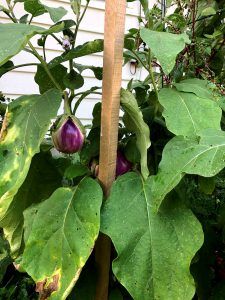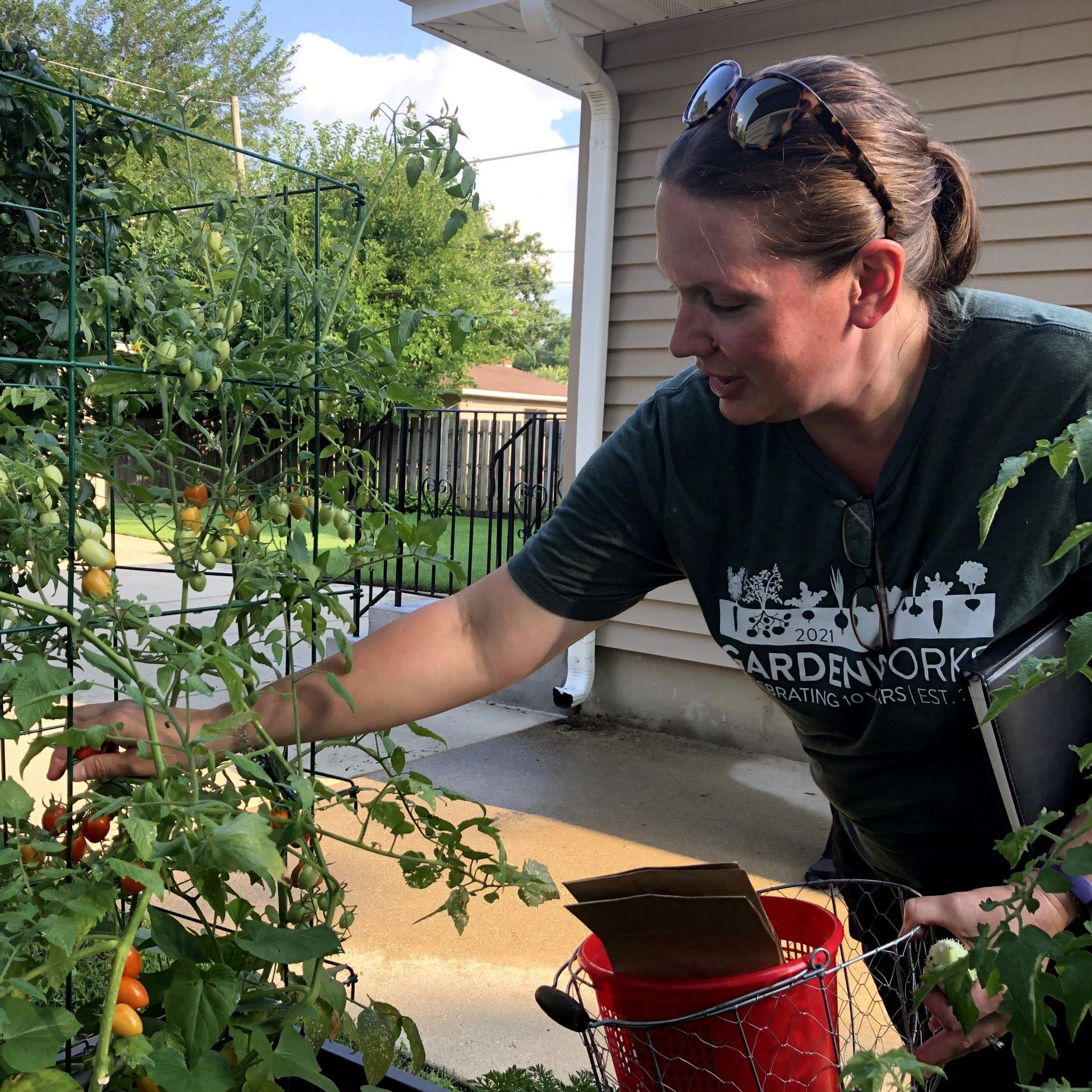All right, I have a bit of a confession to make. Even though I have been involved with the GardenWorks Project for the past three years, as I feel strongly about fighting hunger, food security and food access, I am actually not a gardener.
Blasphemous, I know, but they still seem to like me here. So, when I was introduced to Lisa Sandoval, a Food Growers Network member, I was intrigued by her story. She mentioned that through seed saving, Lisa was able to provide a GardenWorks participant with eggplant seeds native to her home nation, Liberia, so that she could grow them in her new home in the U.S. Besides being an avid lover and regular consumer of eggplant (so I was already slightly partial), I thought that was pretty resourceful–and quite heartwarming being a transplant to the area myself.

I used to think gardens were primarily a backyard thing. As I walked up to Lisa Sandoval’s home, though, I was met with a large plot of plants that seemed to be enjoying the late summer sun. I walked around an extremely impressive core of chard, tomatoes, melon with a decorative sprinkling of ‘volunteer’ pumpkins starting to get their footing, and a neighbor’s pollinator garden with milkweed (which I learned attracts butterflies), all before getting within a newspaper’s throw of the front door.
A 911 dispatcher who moved to Illinois from the Bay Area in 2014, Lisa comes from a family of farmers. Her mother hails from a family with 13 kids and used farming/gardening to feed her family. Her father, a former chef in Lisle, has his favorite seeds. While he stays loyal to certain seed brands, Lisa assures he can ‘propagate almost anything indoors.’ Lisa started growing food as a part of her family’s diet somewhat dated back to her time in California. She recalls the advantages of the more temperate climate in California. Though not an avid gardener at the time, the lemon, peach, persimmon and guava trees on her property served as a supplement to her family’s diet (Anyone else jealous? Just me? Okay.).
After the move to Illinois, she aimed to leverage her flexible schedule to find a way to eat healthier less expensively as a proactive measure against her family’s history of Type 2 diabetes. She began as a volunteer with The GardenWorks Project, and during this time, she was introduced to the concept of seed libraries. She started gardening with 2 pots and borrowed seeds from the Downers Grove and St. Charles Seed Libraries. As a frequent user of the local library myself, the terminology was somewhat familiar, but I had not heard of the concept of seed libraries. I learned it operates similar to libraries for other things (books, music, movies, etc.), only at a seed library, seeds from produce are packaged and made available to the community. The ‘return’ is for patrons to pull the seeds from the produce they grow and give it back to the library to share with other patrons.
In the search for how to best use the seeds she stewards, Lisa enrolled in a seed saving course with the GardenWorks Project. Since then, her initial 2 pots have grown to take over 6 different areas of gardens, including a repurposed LittleTikes ® Table and a fenced in patch of yard where tomato plants were expected to grow up the fence (keyword: were, turns out you can’t control plants but so much).
In her own family, Lisa picks what she grows using a bit of a system. She chooses products that her family will eat, and she gives her children liberties to choose seeds from her personal library to get them further involved in the gardening process. Second, she plants a ‘rainbow’, in terms of colors as well as whatever ‘fun stuff’ she gets from the GardenWorks Project Food Growers Network.
Seed sharing and libraries struck me as a simple, effective and portable idea to increase the diversity of produce within a garden and help someone feel a little closer to home. Lisa’s main qualification for seeds? “Seeds that are prolific enough that what you end up with is cheaper than what you can get from the store.”
As we walked through the areas of the garden, I was amazed at the variety of produce she grew in a relatively small area. She shared the tomatillo, Mortgage Lifter tomatoes, chard and jalapenos, and less common varieties, including purple oval basil, blackberry tomatoes, lemon basil and of course, eggplant.
Every garden has a story, and this one probably has a book’s worth. Lisa told us of the origin of each plant, not scientifically but rather, how it ended up in her garden and, more touching to me, who it helped.
What brought me to Lisa’s gardens was the neighborly story of Lisa provided seeds for a varietal of eggplant a client was used to growing in her native country, Liberia. A Peruvian friend familiar with Aji Amarillo paste wanted to recreate it in the U.S., but between the longer harvest cycle and the pepper’s seeds being more difficult to find, doing so was not proving successful. After being sent a post through a local mom’s group, Lisa found and cultivated the seeds, and surprised her friend with the paste.
The Thai chilies on the side of the house? A local babysitter’s stepdad traded chiles and seeds with her family (not recommended as compensation for all babysitters). The pear-shaped tomato, Japanese Black Trifele? Those returned to her garden after seeds from a previous harvest were given to a neighbor with a hydroponics garden,who then gave back tomatoes from the seeds saved.
From learning that her son’s Little Tykes ® table can actually grow a stalk of corn despite its shallow depth (it’s one ear, but it’s a win) to the discovery that large animals will still find a way into a fenced-in tomato patch, the seed saving and sharing process continues to be a learning experience for Lisa. At the end of it, Lisa says growing is ‘fun for me and it’s fun sharing it.’
In walking around Lisa’s garden and listening as she presented each plant, I marveled at the stories she shared and the community that was created, starting with these seeds. I wondered if she would have ever been able to meet as many people as she has in her gardening journey without seed saving.
With the boom of gardening during the pandemic, I think many of us have received a great opportunity to participate in the continued heritage of seed sharing. Whether it’s growing plants to nourish our families and share with others or the joy of growing and enjoying something that causes us to wax slightly nostalgic, I look forward to one day also experiencing and sharing the gift that caring for the land, our food and ourselves truly is.
About Jennifer Charles
Jennifer’s earliest and fondest memories of gardening were with her father in the backyard of their New Jersey home. Though she is admittedly too scared of bugs to become a full-fledged gardener in adulthood, Jennifer has enjoyed food and feeding people since childhood. This affection led her to pursue a career in the hospitality industry including positions in foodservice, catering and event planning. After volunteering with Northern Illinois Food Bank processing donations, she learned about food insecurity and wanted to help on a deeper level that aligned with her interest in nutrition. In 2018, Jennifer had the honor of working with The Gardenworks Project on its fall fundraiser and fell in love with its concept and mission. She looks forward to learning more about gardening and helping to eliminate food insecurity in her adopted home. Jennifer holds a Bachelor of Science in Foodservice Management from Johnson & Wales University and an MBA from Roosevelt University. In her spare time, Jennifer enjoys cooking, exercising, and reading.



